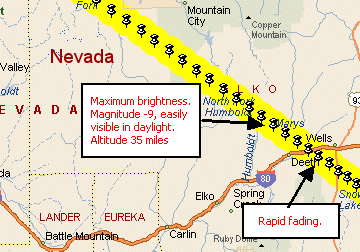 New! Sky Calls is an astronomy-based educational program, perfect for home schoolers. Check it out.
New! Sky Calls is an astronomy-based educational program, perfect for home schoolers. Check it out.
GENESIS FIREBALL: On Wednesday morning, September 8th, a daylight fireball will streak across the western United States. It's the Genesis capsule returning samples of the Sun to Earth. Get the full story from Science@NASA.
 JUST RELEASED: A detailed map of the Genesis ground track shows the changing visual magnitude of the fireball as it traverses Oregon, Nevada and Utah. The fireball will be most luminous over northern Nevada. Credit: Bill Cooke of NASA, based on calculations by Los Alamos fireball expert Douglas ReVelle.
JUST RELEASED: A detailed map of the Genesis ground track shows the changing visual magnitude of the fireball as it traverses Oregon, Nevada and Utah. The fireball will be most luminous over northern Nevada. Credit: Bill Cooke of NASA, based on calculations by Los Alamos fireball expert Douglas ReVelle.
Observing Tips: To see the fireball, you must be within 50 miles of Genesis' ground track. Watch the sky between between 8:52 and 8:56 a.m. PDT. Unless you're directly beneath the track, the fireball will likely be low in the sky, so pay attention to the horizon. Better yet, travel to the ground track, if you can, and look straight up.

Click to view the complete map.
The biggest town in position to view the event is Elko, NV (pop. 16,000). Click here to view an Excel file describing the fireball's sky-path over Elko. Advanced users of Rob Matson's SkyMap program can use this rocket trajectory file to produce sky maps for their own location. ("Time 0 in the rocket trajectory file should be set to 13:54:00 UT on September 8," says Bill Cooke.)
RADIO GENESIS: When Genesis reenters, the capsule will blaze a radio-reflecting plasma trail in the atmosphere above Oregon and Nevada. Ham radio operators might wish to try meteor-burst communications through that area between, say, 8:52 a.m. and 8:56 a.m. PDT on September 8th. Also, radio meteor listeners should turn their antennas toward the reentry path and listen for unusual pings.
MOON SHOT: "It's hard to beat the beauty of a Moon in a deep blue daytime sky," says amateur astronomer Becky Ramotowski. And to prove it, she took this picture on Sept. 5th from Tijeras, New Mexico:

"Notice how bright the crater Aristarchus appears on the upper left," notes Becky. The next few days are good ones for daylight moon watching. Simply step outside around, say, 9 o'clock in the morning, and look southwest. It really is beautiful; don't miss it!
DISAPPEARING STAR: On Sept. 5th, a 9th magnitude star named "TYC 0561-01224-1" winked out for almost 6 seconds while asteroid 754 Malabar glided in front of it. Giancarlo Ubaldo Nappi of Belo Horizonte, Brazil, captured the event on video: click here to see it (623 kb). There are lots of asteroids in the solar system, and they block out stars more often than you might think.

